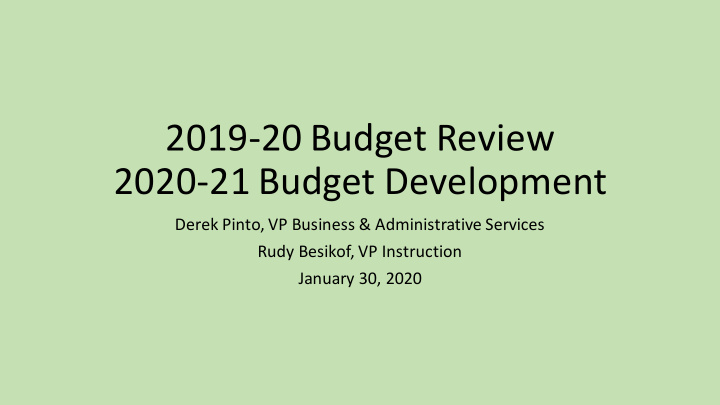



2019-20 Budget Review 2020-21 Budget Development Derek Pinto, VP Business & Administrative Services Rudy Besikof, VP Instruction January 30, 2020
Agenda • 2019-20 Budget Allocation • 2019-20 Budget v. Actuals • 2020-21 CA Demographic and Enrollment Trends • 2020-21 Budget Augmentation Process • 2020-21 Budget Development Process • Proactively Addressing FCMAT Recommendations • Governor’s Budget Proposal: Themes & Community Colleges • Questions
Budget Allocation District & Laney FY 2019-20 Total District Revenue $153,025,964 Total Exclusions (Retiree Benefits, OPEB Debt Services, DSPS Contribution) $17,209,000 Applicable Revenue $135,816,964 Full time Faculty Salaries & Benefits $42,086,448 Part time Faculty $10,250,680 Available Revenue $83,479,836 LANEY 3 year FTE Rolling Average % 36.92% Revenue Allocated $36,307,182 Source: Annual Adopted Budget 2019-20 – Draft – Board of Trustees Meeting on September 10, 2019
Budget vs. Actual FY 19-20 Fund 01 Final Budget Actual as of Jan. 10 2020 Difference % Available Full Time Academic 10,908,549 3,822,221 7,086,328 65% Academic Admin 1,425,531 636,959 788,572 55% Other Faculty 1,611,312 873,354 737,958 46% Part Time Academic 3,152,822 4,583,437 (1,430,616) -45% Classified Salary 5,858,633 2,661,887 3,196,746 55% Fringe Benefits 11,132,681 5,544,187 5,588,494 50% Books, Supplies, Services 2,385,614 878,648 1,506,966 63% Total 36,475,142 19,000,694 17,474,448 48% PT Academic includes: Final Budget Actual as of Jan. 10 2020 Difference % Available Coaches 71,459 47,996 23,463 33% Counselors 72,280 36,334 35,946 50% Department Chairs 13,000 28,566 (15,566) -120% Instructor - Retiree 0 125,881 (125,881) N/A Instructor-Sub-Daily/Sick 25,541 26,191 (649) -3% Instructor-Temp/PTime 2,869,529 3,927,180 (1,057,651) -37% Instructor-Temp/Pt-Office Hour 0 302,894 (302,894) N/A Librarians 51,029 67,799 (16,770) -33% Other Non-Teaching Assignments 49,984 20,596 29,388 59% Total 3,152,822 4,583,437 (1,430,616) -45%
Instructional Expenditure FY 19-20 (as of Dec.) Fund 01 and Parcel Tax (Fund 12) Instructional Expenditure Budget Actuals (as of Dec.) Available FT Instructor (1101) 10,908,549 3,728,316 7,180,233 PT Instructor (1351) 2,869,529 3,927,180 (1,057,651) Instructor-Sub-Daily/Sick 25,541 26,191 (649) Instructor - Retiree PT Instructor Budget 125,881 0 Instructor-Temp/Pt-Office Hour 0 302,894 (302,894) Instructional Aides 917,317 404,861 512,456 Instructional Aides (Replace) Discretionary Budget 12,721 0 Instructional Aides - Student Discretionary Budget 64,320 0 Instruct Aides-O/T/Perm & Non Discretionary Budget 244 0 Fund 12 Parcel Tax 2,953,600.00 0 2,953,600
California Demographics Mark Schniepp, January 15, 2020
CCC Enrollment 1992-2018 Mark Schniepp, January 15, 2020
CCC On-Campus Enrollment /FTES Mark Schniepp, January 15, 2020
CCC Distance Education/FTES Mark Schniepp, January 15, 2020
FY 2020-21 FTEF Allocation
Moving Forward • Schedule within allocations • SPRING 2020 as reference • Division Targets for: FTES, COMPLETIONS, PRODUCTIVITY • Leverage Student-Centered Funding Formula (SCFF) to increase opportunity for completion • Support Pathways-based planning, Distance Education
FY 2020-21 Budget Development Date Action (approximate timeframe) September- Capture Needs • Comprehensive/Annual Program Reviews on select programs and services – collect December resource needs Review of Actuals • Analysis of expenses for last 3 years and current year-to-date spending 2019-20 budget • Review position control January- Prioritize Resources • Comprehensive Program Review (CPR) Validation process February • Requests forwarded to allocation committees • Committees review and rank priorities requests
FY 2020-21 Budget Development Date Action (approximate timeframe) February Present Needs & Priorities • Resource prioritization committees present ranked recommendations for resource augmentation to Budget Advisory Committees and College Council • College President presents college wide needs to District Planning and Budget Committee February- Discuss Recommendations • Budget advisory reviews and makes recommendations to College Council March • College Council reviews recommendations from Budget Advisory Committee April Adopt Final Budget • College adopts final 20-21 budget • President submits budget to District Finance
FY 2020-21 Budget Augmentation Process Step Process 1 All operational budgets will be loaded at 90% of previous year 2 10% withheld will create a budget pool to fund current augmentation requests 3 All departments have the opportunity to apply for funding in addition to the 90% rollover through the CPR and APR process 4 Review and prioritize all requests for additional funding based on the rubric, ranked from highest priority to lowest until the budget pool is exhausted 5 Budget Advisory Committee makes recommendation to College Council
FY 2020-21 Budget Development
FY 2020-21 Budget Development
Laney Proactively Addressing FCMAT Recommendations Recommendation Laney Status • Develop an internal budget calendar (for processes) Completed • Share the budget calendar with all departments, instead of only posting it on the website In Progress • Consider implementing and adhering to prescribed budget timelines to support and enhance budget development In Progress • Provide ongoing budget training for participatorygovernance teams, college business offices and district office staff In Progress • Provide ongoing staff development for position control system to human resources, payroll, and budget staff In Progress • Require each college to complete their own reconciliations and submit to the district office for review In Progress • Provide training to staff to properly complete year-end closing practices In Progress
Governor’s January Budget Proposal: Themes • Addressing affordability crisis – health care and housing • Investing in emergency response – homelessness and wildfires • Promoting opportunity – increased funding for preschool, public schools, and higher education; new Dept. of Early Childhood Development Source: The Annual Workshop on the Governor’s Proposed Budget 2020-21, January 15, 2020
Governor’s January Budget Proposal: What about Community Colleges? Expanding and Supporting Apprenticeship Opportunities One-time funding to expand work-based learning models and programs Streamlining Support and Technical Assistance Strong Workforce Project Increased funding support for (but not limited to): Zero-Textbook-Cost Degrees Programs ($10m) Food Pantries ($11.4M) Expand work-based learning within Guided Pathways ($20m) Create statewide pilot fellowship program for diverse hiring ($15m) Purpose: improve faculty diversity through recruitment/mentorship Source: ACBO/ACCCA Joint Analysis PPT, January 10, 2020
Governor’s January Budget Proposal: What about Community Colleges? Continued Implementation of the Student-Centered Funding Formula No changes to Student Centered Funding Formula (SCFF) Formula Oversight Committee recommendation: 1 st generation college students to be included (future) Chancellor’s Office will publish preliminary formula funding rates in mid-February Source: ACBO/ACCCA Joint Analysis PPT, January 10, 2020
Questions?
Recommend
More recommend